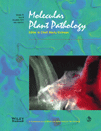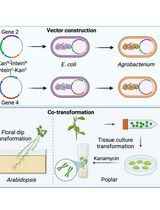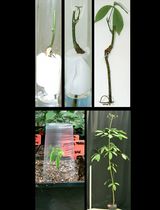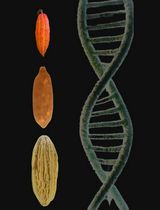- EN - English
- CN - 中文
Agrobacterium rhizogenes-Based Transformation of Soybean Roots to Form Composite Plants
发根农杆菌转化大豆根部形成复合植物
发布: 2016年01月20日第6卷第2期 DOI: 10.21769/BioProtoc.1708 浏览次数: 11557
评审: Zhaohui LiuJoern KlinkenbergTeresa Lenser
Abstract
Transgenic soybean roots of composite plants are a powerful tool to rapidly test the function of genes and activity of gene promoters. No tissue culture is needed, thus avoiding loss of valuable material due to contamination. This is a simple technique that requires less training and care than tissue culture techniques. Furthermore, it takes less time to produce transgenic roots than techniques using sterile tissue culture. If the transgenic roots are to be challenged with a pathogen, there is no need to produce axenic pathogens with this technique, because sterile tissue culture medium is not used. Therefore, there is no agar medium on which contaminants may grow resulting in obscured results or diseased roots. Here, we describe the production of transgenic soybean roots on 7-day-old soybean seedlings using Agrobacterium rhizogenes. These composite plants may be grown in the greenhouse for further experimentation, such as to determine the effect of gene expression on nematode development.
Materials and Reagents
- 17 x 100 mm, 14 ml culture tubes designed for bacteria
- Sodium hypochlorite (Commercial Bleach-Clorox)
- Soybean seeds (William 82) (Glycine max)
- Agrobacterium rhizogenes strain K599 (Homemade culture)
- PRAP15, pRAP17 or other plasmid
- Tetracycline hydrochloride, min. 95% (Sigma-Aldrich)
- Murashige & Skoog Medium- including vitamins (Duchefa Biochemie, catalog number: P08805.02 )
- Ethyl alcohol (The Warner Graham Company, Gas, catalog number: 64-17-5 )
Note: Currently, it is “Sigma-Aldrich, catalog number: 64-17-5 ”. - Anti-bacterial soap (Clean & smooth)
- MS salts
- 3% sucrose
- Casein digest peptone
- Yeast extract
- Dipotassium phosphate (K2HPO4)
- Potassium phosphate (K3PO4)
- Glycerol
- KOH
- MS media (see Recipes)
- Terrific Broth, Modified (Research products International Corp., catalog number: 31237 ) (see Recipes)
- Fertilizer-Peters Excel 13-2-13 150 ppm nitrogen (pH 6.1) (see Recipes)
Equipment
- 162 pots flat trays and 32 pot flats (Myers Lawn&Garden)
- Promix Flexible Purpose (Pro-Mix, model: Flex Loose 2.8 cuft )
- Heated growing mat (Home depot)
- 1 L culture flasks (Pyrex)
- Spectrophotometer UV-120-02 (Shimadzu Corporation, catalog number: 204-00010-08 )
- Centrifuge with a GSA rotor (model: Sorvall RC-5B Refrigerated Super speed Centrifuge)
- Plastic pasteur pipette (Corning, Falcon®, catalog number: 357575 )
- A desiccator attached to a vacuum pump
- G10 Gyrotory shaker (New Brunswick Scientific)
- Gyrotory water bath Shaker (LabX, New Brunswick Scientific, model: G76 )
- Buckets (Home depot)
- Growth chamber
- Stainless steel scissors (Roboz Surgical Instrument Co., catalog number: RS-5912 )
- Dark Reader Spot Lamp-SL85 (Clare Chemical Research)
- Orange filter glasses (Clare Chemical Research)
- Patio/Paver Sand. Multi-purpose (Pavestone)
- 50 ml disposable plastic beakers
- Clear plastic tub
- Rotating platform
- Thermo Fisher Scientific Nalgene Spherical-Bottom Centrifuge Bottle, Polycarbonate (PC)-Jade Scientific Inc./ NalgeneTM Spherical-Bottom Polycarbonate Centrifuge Bottle (Thermo Fisher Scientific, catalog number: 3123-0250 )
- Vacuum 380 mm Hg (Torr)
Procedure
文章信息
版权信息
© 2016 The Authors; exclusive licensee Bio-protocol LLC.
如何引用
Matthews, B. F. and Youssef, R. M. (2016). Agrobacterium rhizogenes-Based Transformation of Soybean Roots to Form Composite Plants. Bio-protocol 6(2): e1708. DOI: 10.21769/BioProtoc.1708.
分类
植物科学 > 植物发育生物学 > 综合
植物科学 > 植物分子生物学 > DNA
植物科学 > 植物转化 > 农杆菌介导的转化方法
您对这篇实验方法有问题吗?
在此处发布您的问题,我们将邀请本文作者来回答。同时,我们会将您的问题发布到Bio-protocol Exchange,以便寻求社区成员的帮助。
Share
Bluesky
X
Copy link














